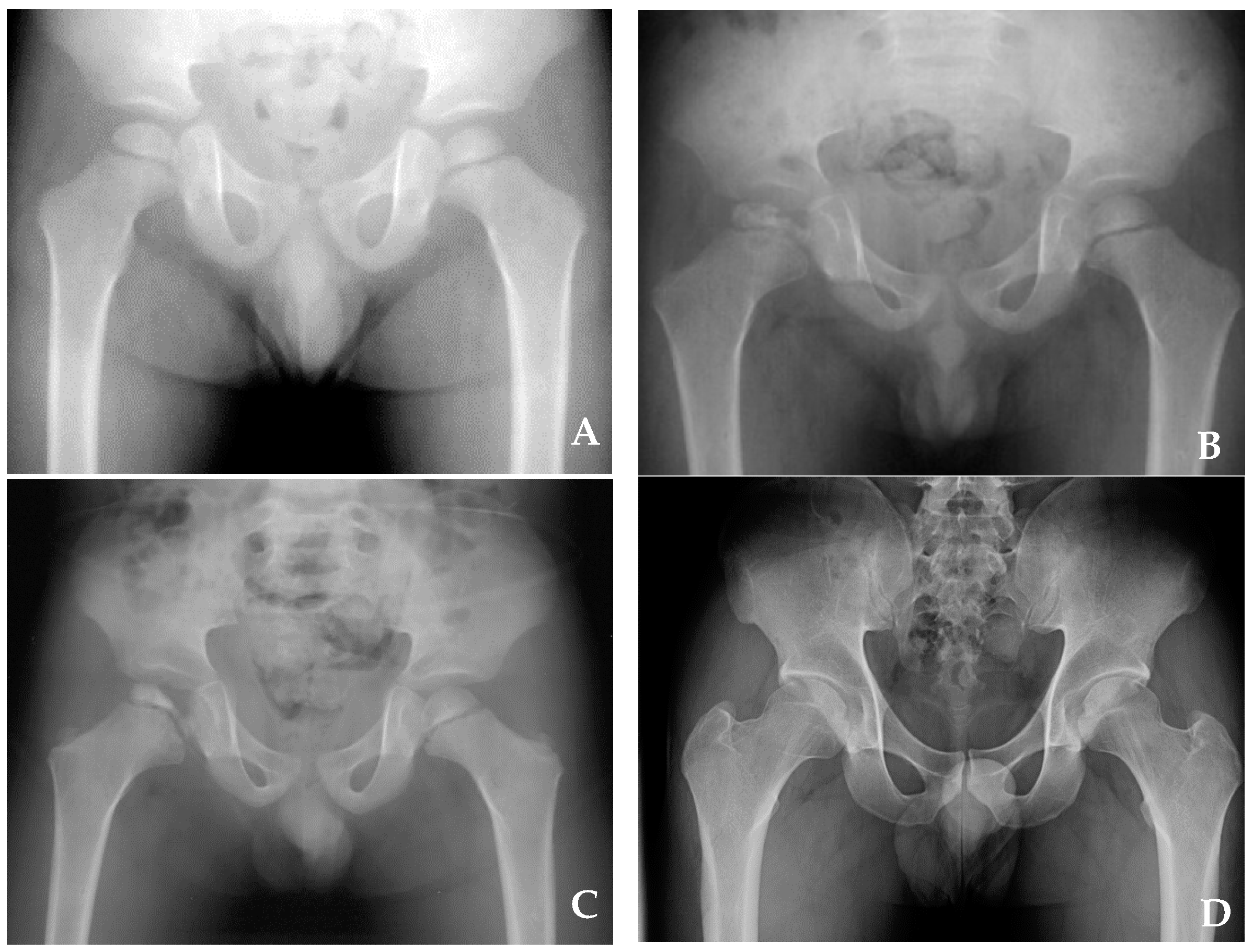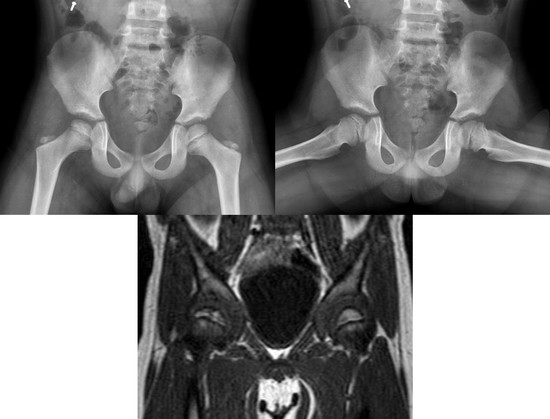Does the Duration of Each Waldenström Stage Affect the Final Outcome of Legg–Calvé–Perthes Disease Onset before 6 Years of Age?
Abstract
1. Introduction
2. Materials and Methods
3. Results
4. Discussion
5. Conclusions
Author Contributions
Funding
Institutional Review Board Statement
Informed Consent Statement
Data Availability Statement
Conflicts of Interest
References
- Catterall, A. The natural history of perthes’ disease. J. Bone Jt. Surg. Br. Vol. 1971, 53, 37–53. [Google Scholar] [CrossRef]
- Ippolito, E.; Tudisco, C.; Farsetti, P. The long-term prognosis of unilateral Perthes’ disease. J. Bone Jt. Surg. Br. Vol. 1987, 243–250. [Google Scholar] [CrossRef] [PubMed]
- Salter, R.B.; Thompson, G.H. Legg-Calve-Perthes disease. The prognostic significance of the subchondral fracture and a two-group classification of the femoral head involvement. J. Bone Jt. Surg. Am. Vol. 1984, 66, 479–489. [Google Scholar] [CrossRef]
- Canavese, F.; Dimeglio, A. Perthes’ disease: Prognosis in children under six years of age. J. Bone Jt. Surg. Br. Vol. 2008, 90, 940–945. [Google Scholar] [CrossRef] [PubMed]
- Gent, E.; Antapur, P.; Mehta, R.L.; Sudheer, V.M.; Clarke, N.M. Predicting the outcome of Legg-Calve-Perthes’ disease in children under 6 years old. J. Child. Orthop. 2007, 1, 159. [Google Scholar] [CrossRef] [PubMed]
- Rosenfeld, S.B.; Herring, J.A.; Chao, J.C. Legg-Calvé-Perthes Disease: A Review of Cases with Onset before Six Years of Age. J. Bone Jt. Surg. Am. Vol. 2007, 89, 2712–2722. [Google Scholar] [CrossRef] [PubMed]
- Nakamura, J.; Kamegaya, M.; Saisu, T.; Kakizaki, J.; Hagiwara, S.; Ohtori, S.; Orita, S.; Takahashi, K. Outcome of Patients With Legg-Calvé-Perthes Onset Before 6 Years of Age. J. Pediatr. Orthop. 2015, 35, 144–150. [Google Scholar] [CrossRef] [PubMed]
- Herring, J.A. Tachdjian’s Pediatric Orthopaedics, 3rd ed.; Saunders: Philadelphia, PA, USA, 2002; p. 675. [Google Scholar]
- Herring, J.A.; Williams, J.J.; Neustadt, J.N.; Early, J.S. Evolution of Femoral Head Deformity during the Healing Phase of Legg-Calvé-Perthes Disease. J. Pediatr. Orthop. 1993, 13, 41–45. [Google Scholar] [CrossRef] [PubMed]
- Joseph, B.; Varghese, G.; Mulpuri, K.; Narasimha Rao, K.; Nair, N.S. Natural evolution of Perthes disease: A study of 610 children under 12 years of age at disease onset. J. Pediatric Orthop. 2003, 23, 590–600. [Google Scholar] [CrossRef]
- Catteral, A. Legg-Calve-Perthes’ Disease. In Current Problems in Orthopaedics; Curchill Livingstone: Edinburgh, UK, 1982. [Google Scholar]
- Catterall, A. Natural history, classification, and x-ray signs in Legg-Calve-Perthes’ disase. Acta Orthopaedica Belgica. 1980, 46, 346–351. [Google Scholar]
- Herring, J.A.; Kim, H.T.; Browne, R. Legg-Calve-Perthes disease. Part I: Classification of radiographs with use of the modified lateral pillar and Stulberg classifications. J. Bone Jt. Surg. Am. Vol. 2004, 86, 2103–2120. [Google Scholar] [CrossRef]
- Cohen, J. Weighted kappa: Nominal scale agreement provision for scaled disagreement or partial credit. Psychol. Bull. 1968, 70, 213–220. [Google Scholar] [CrossRef] [PubMed]
- Ippolito, E.; Tudisco, C.; Farsetti, P. Long-Term Prognosis of Legg-Calvé-Perthes Disease Developing During Adolescence. J. Pediatr. Orthop. 1985, 5, 652–656. [Google Scholar] [CrossRef]
- Snyder, C.R. Legg-Perthes disease in the young hip--does it necessarily do well? J. Bone Jt. Surg. Am. Vol. 1975, 57, 751–759. [Google Scholar] [CrossRef]
- Ingman, A.M.; Paterson, D.C.; Sutherland, A.D. A Comparison between Innominate Osteotomy and Hip Spica in the Treatment of Legg-Perthes? Disease Clin. Orthop. Relat. Res. 1982, 141–147. [Google Scholar] [CrossRef]
- Clarke, T.E.; Finnegan, T.L.; Fisher, R.L.; Bunch, W.H.; Gossling, H.R. Legg-Perthes disease in children less than four years old. J. Bone Jt. Surg. Am. Vol. 1978, 60, 166–168. [Google Scholar] [CrossRef]

| Sex | Boy:Girl (Hips) | 47:2 |
|---|---|---|
| Location | Right:Left (hips) | 24:25 |
| Age | Average (Minimum~Maximum) | 3.9 (1.9~5.9) |
| Follow-up duration | Average (Minimum~Maximum) | 14.3 (6.2~27.8) |
| Lateral Pillar Class | Good (Stulberg Class I or II) | Fair (Stulberg Class III) | Poor (Stulberg Class IV or V) |
|---|---|---|---|
| A | 1 | 0 | 0 |
| B | 26 | 3 | 0 |
| B/C, C | 3 | 10 | 6 |
| Stulberg Class I or II | Stulberg Class III, IV, or V | p-Value | |
|---|---|---|---|
| Group I (age < 4 years) | 14 | 11 | 0.162 |
| Group II (age ≥ 4 years) | 18 | 6 |
| Stulberg Class I or II | Stulberg Class III, IV, or V | p-Value | |
|---|---|---|---|
| Initial | 4.1 (0.7~9.8) | 6.2 (2.6~13.5) | 0.009 |
| Fragmentation | 5.9 (1.0~16.0) | 11.9 (4.2~23.6) | <0.001 |
| Lateral Pillar | Stulberg | ||||
|---|---|---|---|---|---|
| A or B | B/C or C | I or II | III | IV or V | |
| Rosenfeld et al. [6] | 115 (61.2) | 73 (38.8) | 152 (80.9) | 17 (9.0) | 19 (10.1) |
| Gent et al. [5] | 39 (56.5) | 30 (43.5) | 45 (65) | 14 (20) | 10 (15) |
| Nakamura et al. [7] | 39 (34.2) | 75 (65.8) | 72 (63.1) | 28 (25.6) | 14 (12.3) |
| This study | 30 (61) | 19 (29) | 30 (61) | 13 (27) | 6 (12) |
Publisher’s Note: MDPI stays neutral with regard to jurisdictional claims in published maps and institutional affiliations. |
© 2021 by the authors. Licensee MDPI, Basel, Switzerland. This article is an open access article distributed under the terms and conditions of the Creative Commons Attribution (CC BY) license (http://creativecommons.org/licenses/by/4.0/).
Share and Cite
Oh, H.-S.; Sung, M.-J.; Lee, Y.-M.; Kim, S.; Jung, S.-T. Does the Duration of Each Waldenström Stage Affect the Final Outcome of Legg–Calvé–Perthes Disease Onset before 6 Years of Age? Children 2021, 8, 118. https://doi.org/10.3390/children8020118
Oh H-S, Sung M-J, Lee Y-M, Kim S, Jung S-T. Does the Duration of Each Waldenström Stage Affect the Final Outcome of Legg–Calvé–Perthes Disease Onset before 6 Years of Age? Children. 2021; 8(2):118. https://doi.org/10.3390/children8020118
Chicago/Turabian StyleOh, Ho-Seok, Myung-Jin Sung, Young-Min Lee, Sungmin Kim, and Sung-Taek Jung. 2021. "Does the Duration of Each Waldenström Stage Affect the Final Outcome of Legg–Calvé–Perthes Disease Onset before 6 Years of Age?" Children 8, no. 2: 118. https://doi.org/10.3390/children8020118
APA StyleOh, H.-S., Sung, M.-J., Lee, Y.-M., Kim, S., & Jung, S.-T. (2021). Does the Duration of Each Waldenström Stage Affect the Final Outcome of Legg–Calvé–Perthes Disease Onset before 6 Years of Age? Children, 8(2), 118. https://doi.org/10.3390/children8020118







